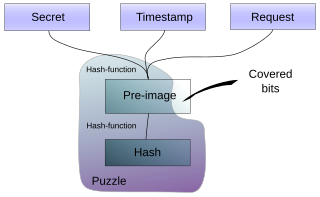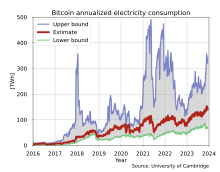Hashcash is a proof-of-work system used to limit email spam and denial-of-service attacks. Hashcash was proposed in 1997 by Adam Back and described more formally in Back's 2002 paper "Hashcash - A Denial of Service Counter-Measure". In Hashcash the client has to concatenate a random number with a string several times and hash this new string. It then has to do so over and over until a hash beginning with a certain amount of zeros is found.

In cryptography, a nonce is an arbitrary number that can be used just once in a cryptographic communication. It is often a random or pseudo-random number issued in an authentication protocol to ensure that old communications cannot be reused in replay attacks. They can also be useful as initialization vectors and in cryptographic hash functions.

Client Puzzle Protocol (CPP) is a computer algorithm for use in Internet communication, whose goal is to make abuse of server resources infeasible. It is an implementation of a proof-of-work system (PoW).

Adam Back is a British cryptographer and cypherpunk. He is the CEO of Blockstream, which he co-founded in 2014. He invented Hashcash, which is used in the Bitcoin mining process.
Trusted timestamping is the process of securely keeping track of the creation and modification time of a document. Security here means that no one—not even the owner of the document—should be able to change it once it has been recorded provided that the timestamper's integrity is never compromised.
Double-spending is a monetary design problem, a good money is verifiably scarce and where a unit of value can be spent more than once, the monetary property of scarcity is challenged. As with counterfeit money, such double-spending leads to inflation by creating a new amount of copied currency that did not previously exist. Like all increasingly abundant resources, this devalues the currency relative to other monetary units or goods and diminishes user trust as well as the circulation and retention of the currency.

Bitcoin is the first decentralized cryptocurrency. Nodes in the peer-to-peer bitcoin network verify transactions through cryptography and record them in a public distributed ledger, called a blockchain, without central oversight. Consensus between nodes is achieved using a computationally intensive process based on proof of work, called mining, that guarantees the security of the bitcoin blockchain. Mining consumes increasing quantities of electricity and has been criticized for its environmental effects.

A cryptocurrency, crypto-currency, or crypto is a digital currency designed to work as a medium of exchange through a computer network that is not reliant on any central authority, such as a government or bank, to uphold or maintain it.

The Bitcoin protocol is the set of rules that govern the functioning of Bitcoin. Its key components and principles are: a peer-to-peer decentralized network with no central oversight; the blockchain technology, a public ledger that records all Bitcoin transactions; mining and proof of work, the process to create new bitcoins and verify transactions; and cryptographic security.
Zerocoin is a privacy protocol proposed in 2013 by Johns Hopkins University professor Matthew D. Green and his graduate students, Ian Miers and Christina Garman. It was designed as an extension to the Bitcoin protocol that would improve Bitcoin transactions' anonymity by having coin-mixing capabilities natively built into the protocol. Zerocoin is not currently compatible with Bitcoin.
Proof-of-stake (PoS) protocols are a class of consensus mechanisms for blockchains that work by selecting validators in proportion to their quantity of holdings in the associated cryptocurrency. This is done to avoid the computational cost of proof-of-work (POW) schemes. The first functioning use of PoS for cryptocurrency was Peercoin in 2012, although the scheme, on the surface, still resembled a POW.
In the context of cryptocurrency mining, a mining pool is the pooling of resources by miners, who share their processing power over a network, to split the reward equally, according to the amount of work they contributed to the probability of finding a block. A "share" is awarded to members of the mining pool who present a valid partial proof-of-work. Mining in pools began when the difficulty for mining increased to the point where it could take centuries for slower miners to generate a block. The solution to this problem was for miners to pool their resources so they could generate blocks more quickly and therefore receive a portion of the block reward on a consistent basis, rather than randomly once every few years.
A blockchain is a distributed ledger with growing lists of records (blocks) that are securely linked together via cryptographic hashes. Each block contains a cryptographic hash of the previous block, a timestamp, and transaction data. Since each block contains information about the previous block, they effectively form a chain, with each additional block linking to the ones before it. Consequently, blockchain transactions are irreversible in that, once they are recorded, the data in any given block cannot be altered retroactively without altering all subsequent blocks.
Monero is a cryptocurrency which uses a blockchain with privacy-enhancing technologies to obfuscate transactions to achieve anonymity and fungibility. Observers cannot decipher addresses trading Monero, transaction amounts, address balances, or transaction histories.
Proof of space (PoS) is a type of consensus algorithm achieved by demonstrating one's legitimate interest in a service by allocating a non-trivial amount of memory or disk space to solve a challenge presented by the service provider. The concept was formulated in 2013 by Dziembowski et al. and by Ateniese et al.. Proofs of space are very similar to proofs of work (PoW), except that instead of computation, storage is used to earn cryptocurrency. Proof-of-space is different from memory-hard functions in that the bottleneck is not in the number of memory access events, but in the amount of memory required.

Firo, formerly known as Zcoin, is a cryptocurrency aimed at using cryptography to provide better privacy for its users compared to other cryptocurrencies such as Bitcoin.
Equihash is a memory-hard Proof-of-work algorithm introduced by the University of Luxembourg's Interdisciplinary Centre for Security, Reliability and Trust (SnT) at the 2016 Network and Distributed System Security Symposium. The algorithm is based on a generalization of the Birthday problem which finds colliding hash values. It has severe time-space trade-offs but concedes vulnerability to unforeseen parallel optimizations. It was designed such that parallel implementations are bottle-necked by memory bandwidth in an attempt to worsen the cost-performance trade-offs of designing custom ASIC implementations. ASIC resistance in Equihash is based on the assumption that commercially-sold hardware already has quite high memory bandwidth, so improvements made by custom hardware may not be worth the development cost.
In cryptography, a memory-hard function (MHF) is a function that costs a significant amount of memory to efficiently evaluate. It differs from a memory-bound function, which incurs cost by slowing down computation through memory latency. MHFs have found use in key stretching and proof of work as their increased memory requirements significantly reduce the computational efficiency advantage of custom hardware over general-purpose hardware compared to non-MHFs.
Nervos Network is a proof-of-work blockchain platform which consists of multiple blockchain layers that are designed for different functions. The native cryptocurrency of this layer is called CKB. Smart contracts and decentralized applications can be deployed on the Nervos blockchain. The Nervos Network was founded in 2018.
GPU mining is the use of Graphics Processing Units (GPUs) to "mine" proof-of-work cryptocurrencies, such as Bitcoin. Miners receive rewards for performing computationally intensive work, such as calculating hashes, that amend and verify transactions on an open and decentralized ledger. GPUs can be especially performant at calculating such hashes.








